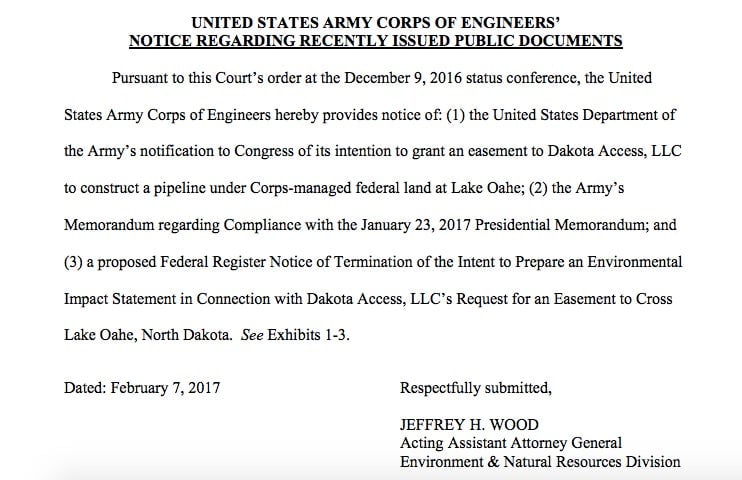The tame language in Trump’s Dakota Access Pipeline memo looks like a brilliant legal move
The US Army Corps of Engineers announced in a letter to Congress and in a Feb. 7 court filing that within 24 hours, it would grant Dakota Access LLC the final easement it needed to complete construction on the last mile and a half of its 1,700-mile pipeline in North Dakota.


The US Army Corps of Engineers announced in a letter to Congress and in a Feb. 7 court filing that within 24 hours, it would grant Dakota Access LLC the final easement it needed to complete construction on the last mile and a half of its 1,700-mile pipeline in North Dakota.
To do this, the Army Corps will need to terminate its work on an environmental impact statement begun less than a month before and approve the pipeline without one. It will also immediately end its public comment period, cutting it short by nearly two weeks, and waive its typical policy to wait 14 days after notifying Congress before granting an easement like this.
Of course, these moves will land the Army Corps back in court, where lawyers for the Standing Rock Sioux tribe have been fighting against the pipeline for seven months. They’ve already vowed to file more litigation in response to the Feb. 7 announcement.
But due to a bit of heretofore uncharacteristic legal restraint on the part of US president Donald Trump, the Army Corps may have the upper hand.

Four days after his inauguration, Trump, who still owned stock in the company building the Dakota Access pipeline as of his last Federal Election Commission filing, signed a presidential memorandum instructing the Army Corps to expedite its review and approve the pipeline “to the extent permitted by law and as warranted.” That memo was a careful piece of legal writing—written much differently than, for example, the president’s immigration ban, with its many apparent legal holes and sweeping mandates that have landed the administration in court and stalled the ban for now.
Whereas the immigration executive order flat-out decreed policy changes—using language like “I hereby suspend entry,” for example, leaving room for questions of legality and presidential overreach to be debated in court—Trump’s memorandum on the Dakota Access pipeline never explicitly demanded the pipeline be approved. It hedged quite a bit, only going so far as encouraging action “as warranted” and as “permitted by law.” So when the Army Corps—the body that is already legally vested with the power to make decisions like this—heeds Trump’s memo, it appears a lot more like a matter of choice than a forced hand.
Industry representatives immediately noted that the memo’s strategically muted language. “While the memorandums look vaguer on the surface (than directly ordering an easement), they’re actually stronger legally and have a better chance in resulting in a positive outcome,” John Stoody, a vice president at the Association of Oil Pipelines, told High Country News shortly after the memo was issued. Once the Army Corps issued its approval, a legal challenge to its decision would harder to mount.
Lawyers for Earth Justice, who are representing the Standing Rock Sioux, have announced they will challenge the easement by focusing on the Army’s abrupt cancellation of its environmental impact statement process—which the Army had already announced in the Federal Register—“on the grounds that the EIS was wrongfully terminated,” calling the decision “arbitrary, capricious and unlawful.”
“The Obama administration correctly found that the Tribe’s treaty rights must be respected, and that the easement should not be granted without further review and consideration of alternative crossing locations,” Jan Hasselman, the lead lawyer on the case, wrote. “Trump’s reversal of that decision continues a historic pattern of broken promises to Indian Tribes and a violation of Treaty rights. Trump and his administration will be held accountable in court.”
Indeed, the termination is a major reversal from the Army Corps’ decision in December, which called for “additional analysis, more rigorous exploration and evaluation of reasonable siting alternatives” due to the Tribe’s treaty rights and the environmental issues involved. But the Army Corps already had conducted a much shorter, less rigorous environmental assessment of the project in 2016, and at the time, found “no significant impact” to the environment—a point which may be raised in court.